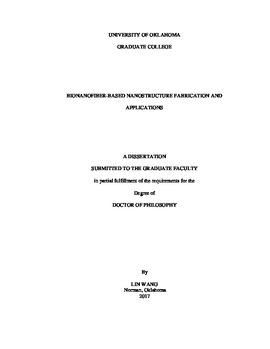| dc.description.abstract | Among various strategies for the synthesis and assembly of nano-scaled structures, bio-templating is an efficient method due to the unique physical and chemical properties of the template bionanomaterials, thus has experienced a rapid and vigorous development in past decades. The works in this dissertation are focused on the one-dimensional (1D) biotemplates, especially filamentous bacteriophages and bacterial flagella. The fabrication of hybrid inorganic/biotemplate 1D nanowires and two-dimensional (2D) films, and the 2D films self-assembled from the biofibers, as well as their potential applications in electric and medical fields were described here.
Firstly, a tunable nanoparticles (NPs) assembly strategy on filamentous protein-based biotemplates which forming 1D nanowires without the need of biotemplate modification was described (Chapter 2). To achieve controlled assembly of NPs on biotemplates, it is usually necessary to either genetically or chemically modify the surface of biotemplates. Here we discovered that simply coating small molecular weight polyethyleneimine (PEI) on NPs triggered their electrostatic assembly on the protein-based biotemplates in a controlled manner. Such strategy is facile and versatile in that the NPs to be assembled and the protein-based biotemplates can be independently changed. The pH values and molecular weights of PEI are the two key factors for the dense assembly of NPs onto the biotemplates. Our method exhibited high flexibility in assembling NPs of different sizes and in controlling the NPs density on the biotemplates, avoiding the costly and tedious steps of modifying biotemplates prior to the assembly. It can assemble multiple types of NPs, regardless of their synthetic methods, onto different wild-type biotemplates such as bacterial flagella, pili, and phages.
Secondly, based on the 1D NPs/flagella assemblies obtained in Chapter 2, we further extended the work to manipulate the optical properties of the 1D structure through a seed-mediated overgrowth process (Chapter 3). The overgrowth process simultaneously increased the AuNPs size on the templates as well as reduced their inter-particle distances, thus inducing 3D coupling of surface plasmon of AuNPs on the template and leading to a significantly enhanced and broadened localized surface plasmon resonance (LSPR) bands. We then took advantage of the broadband absorption property of the overgrown AuNPs assemblies and used them as effective solar absorbers. The as-constructed plasmonic absorber exhibited efficient solar-thermal conversion. When such absorber was used in a solar thermoelectric generation (STEG) device, it has been demonstrated capable of generating 1V voltage under 5x solar irradiation.
In addition, a type of 2D film self-assemblied from genetically engineered phage nanofibers was fabricated as artificial extracellular matrix (aECM), and the osteoblastic differentiation of mesenchymal stem cells on the matrix without osteogenic supplements was demonstrated (Chapter 4). The generated virus-activated aECM was with ordered ridge/groove nanotopography and displayed different fibronectin-derived peptides (RGD, its synergy site PHSRN, and a combination of RGD and PHSRN). The unique nanotopography and the display of RGD and PHSRN could induce the osteoblastic differentiation of mesenchymal stem cells (MSCs) without any osteogenic supplements. The aECM formed through self-assembly and genetic engineering of phage can be used to understand the role of peptide cues in directing stem cell behavior while keeping nanotopography constant. Moreover, the materials showed huge potential in the application of bone regeneration. | en_US |
